
How to install a dishwasher: a step-by-step guide
Installing a new dishwasher can seem like a challenging task, but it can be done with the proper plumbing and electric requirements and a close look at your product’s installation instructions. Whether you’re replacing an old dishwasher or installing your kitchen’s first model, you can use this guide as a general outline for the installation process. Specific installation instructions vary by model, so be sure to reference your dishwasher’s use and care guide throughout the process. And always consult a professional for help if you are unsure. If you’re still shopping for a new dishwasher, explore the innovative options available from Whirlpool brand.
Before you start - what do you need to hook up a dishwasher?
To hook up a dishwasher, you need an existing water line, a draining line and a power cord. Ensure there are no existing utility connections in your cabinet opening before beginning the installation process. Check your owner’s manual for model-specific instructions for installing a dishwasher.
Do dishwashers come with a water supply line?
While most dishwashers come with a water supply line, some models do not include one. However, Whirlpool brand has the dishwasher installation parts you need to get started, including water supply hose kits, power cords and more.
Installing & hooking up a dishwasher
Installing a dishwasher is a task that involves removing your old appliance (if applicable), connecting water lines, connecting electric lines, leveling your machine and running tests to ensure the appliance is functioning properly. If you’re installing a dishwasher for the first time, you can expect the process to take at least two hours. The process will take longer if you have to remove an old dishwasher before the installation can begin. Be sure to have the assistance of at least one other person as you will need to carefully lift and tilt the appliance during installation. Get a feel for the process with these step-by-step directions below in addition to your appliance’s product manual instructions as installation steps may vary by model.
Supplies
- Shallow pan or bucket
Towel or large piece of cardboard
Flashlight
Water line installation kit
Power cord
Tools
- Parts included with your dishwasher
Cordless drill
Adjustable wrench
Socket wrench
Screwdrivers
Level
Pliers
Measuring tape
Utility knife
Additional tools or supplies as listed in installation instructions
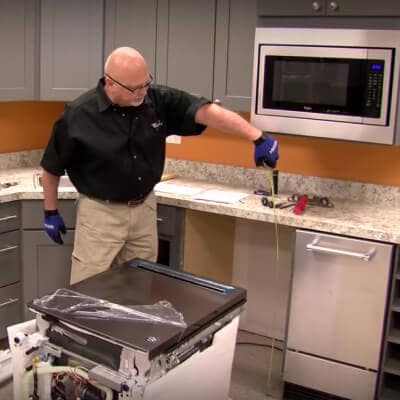
Step 1: Measure dishwasher dimensions
If you’re installing a dishwasher at a new location in your kitchen or installing one for the first time, you'll want to ensure you have the right cabinet opening dimensions. Measure the cabinet opening for width, depth and height to ensure the right fit for your appliance. Additionally, you’ll want to ensure you have ample space for the dishwasher air gap if applicable for your new dishwasher.
Step 2: Remove the current dishwasher (if applicable)
Before you uninstall your current dishwasher, turn off the electrical power to the dishwasher at the circuit breaker and cut the water supply to the appliance. Once you have successfully shut off the water and electricity, unplug the dishwasher from the outlet and disconnect the water supply lines and drain hose. Use a towel, shallow pan or bucket to catch any excess water leaking from the drain hose.
Next, remove the screws that anchor the dishwasher to your cabinets and countertop. Using a screwdriver, remove the front access panel below the dishwasher door and adjust the leveling legs in each corner to make removal of the dishwasher easier. To help protect your floors from scuffs and scratches, place a bath towel or a large piece of cardboard in front of the dishwasher before you begin to pull out the appliance from the cabinet opening. Slide the old machine onto the towel or cardboard and move it out of the way before installing the new dishwasher.
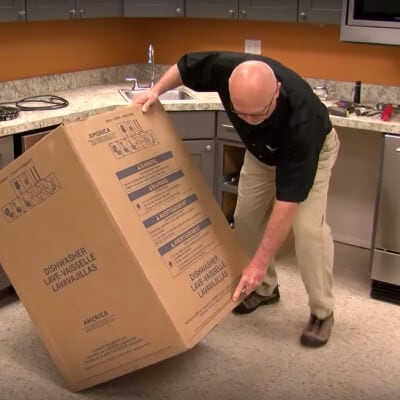
Step 3: Prepare the new dishwasher for installation
Open the cardboard box that your appliance arrived in and remove shipping materials. Save a large piece of the cardboard for the installation process. Open the dishwasher door to remove any styrofoam or wrap from the interior. Set aside any parts or tools packaged separately inside the box.
With the help of at least one other person, gently tilt the dishwasher on its back. Then, remove the front access panel. If your model has a drip tray, disconnect the tray sensors. Route the power cord through the terminal box and connect the remaining wires per your product manual instructions. Attach the drain hose to the drain port, then route the drain hose and power cord underneath the rear legs of the dishwasher.
If your dishwasher comes with an insulation blanket, it may fit tightly in your cabinet opening. Be mindful to keep this in place as insulation blankets help reduce the sound level while the appliance is running. Refer to your owner’s manual to see if this is included with your dishwasher.
Tip:
Save the wood runners from your new dishwasher’s packaging. If you need to fit the appliance in a slightly wider cabinet, the wood runners can sometimes be used as shims for a proper fit.
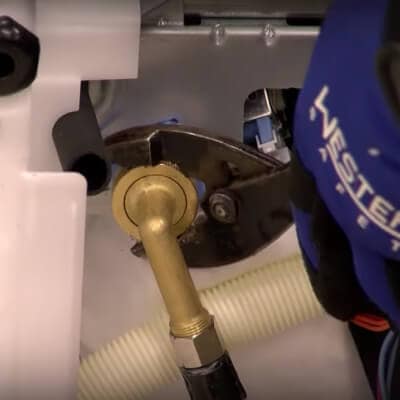
Step 4: Attach water supply to dishwasher
Attach the 90 degree elbow fitting onto the water supply line and connect the fill hose to the valve located on the bottom of the dishwasher and tighten by hand, then tighten an additional ¼ to ½ turn with pliers. Do not apply Teflon tape or thread sealer to the water valve threads. Make sure the rubber washer is present inside the water hose fitting. Route the water supply line toward the rear of the dishwasher.
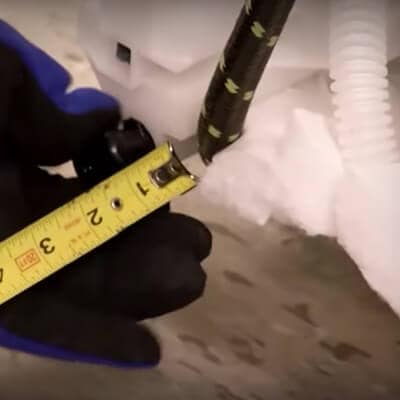
Step 5: Level and adjust the height of the appliance
Measure your cabinet opening height and adjust your dishwasher’s rear leveling legs to match. Use a level to ensure leveling legs are even, as dishwashers require level placement for proper water drainage.
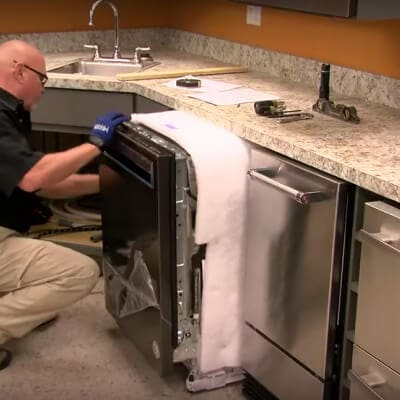
Step 6: Move the dishwasher into place
With the help of at least one other person, carefully tilt the dishwasher upright onto a large piece of cardboard and move it toward the desired location. Route the power cord, drain hose and water supply line through the sink cabinet. Avoid backwash from the sink’s drain by securing slack in the drain hose to the backside of the cabinet under the sink. Make sure the hose arches higher than the drain inlet. Slide the dishwasher into the cabinet opening.
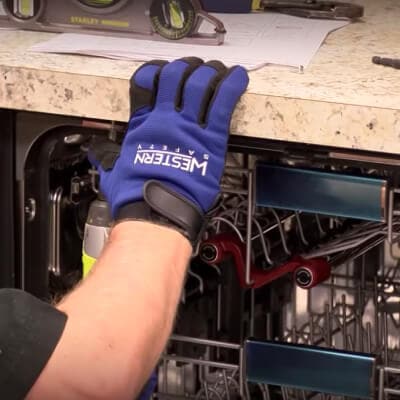
Step 7: Secure the dishwasher to your cabinets and countertops
Attach anchor brackets to the top of the dishwasher collar on the left and right side, then slide the dishwasher back until the exterior is flush with the surrounding cabinet doors. Check the levelness along the top edge of the dishwasher with a level and adjust the front level legs as needed to ensure the legs are firmly against the floor. Once level, screw in the anchor brackets to secure the dishwasher in place.
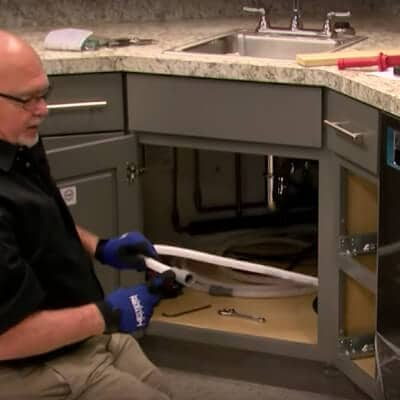
Step 8: Connect hoses and power to dishwasher
Following your product manual’s instructions, attach the water supply line to the hot water line and turn on the water at the shut-off valve. Connect the drain hose to the drain port, then plug in the power cord. If the dishwasher has a drip tray, reconnect it. Turn your electric back on at the circuit breaker, as well as the appliance’s water supply.
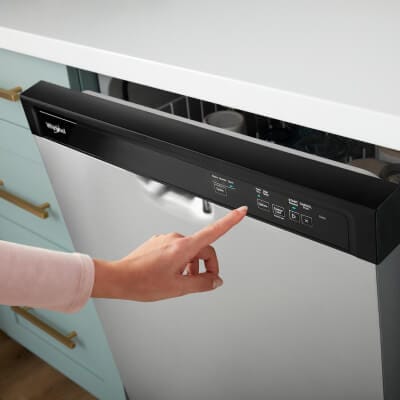
Step 9: Run a dishwasher test cycle
To check for leaks or other performance issues, run a test cycle on your new dishwasher. Test cycle instructions vary by model, so be sure to consult the testing instructions provided in your product manual. Once your dishwasher has passed its test cycle, attach the front access panel, making sure the side with printing on it faces the dishwasher, and peel off the protective plastic lining from the exterior.
Dishwasher installation troubleshooting tips
Having trouble with your dishwasher installation? Refer to these dishwasher troubleshooting tips to help get your appliance up and running.
Not draining properly: Keep in mind that it is normal to see a bit of standing water at the bottom of the dishwasher tub. However, excess water could be a sign of a clogged dishwasher filter.
Not filling with water: If your dishwasher is not filling with water, there may be an issue with the drain hose or water supply valve.
Not turning on: If your dishwasher won’t start, ensure the circuit breaker is turned on, and check the settings for sleep mode or a control lock. Or, shut off the circuit breaker for one minute and turn it back on.
Not flush with cabinets: Be mindful to measure the depth of your dishwasher and the opening to ensure it can be installed far back enough to sit flush with your cabinets. Carefully slide the appliance into the opening until it is flush.
- Door hits underside of countertop: Your dishwasher should be installed under the countertop and have enough clearance for the door to open and close. If the dishwasher door hits the bottom of the countertop, try adjusting the leveling legs. Ensure the space between the dishwasher cabinet opening and tub is equal on each side. If it is not, consider loosening the brackets and shifting your dishwasher so it is aligned. Secure brackets again once finished.
Dishwasher installation FAQs
Before you get started on your dishwasher installation, discover the answers to some frequently asked installation questions.
How hard is it to install a dishwasher? Can I do it by myself?
The difficulty level can vary by experience, equipment, existing connections and installation location. Use two people when you are installing a dishwasher. It is recommended to have a moderate level of experience working with plumbing and electricity to install a dishwasher without professional help. You may want to consider hiring a professional if you have never installed a large appliance before or if you don’t have direct access to your desired installation location.
Can I get help with installing a dishwasher?
If you’re not comfortable installing your dishwasher yourself, Whirlpool brand offers professional delivery and installation services for most major appliances that can be scheduled upon checkout.
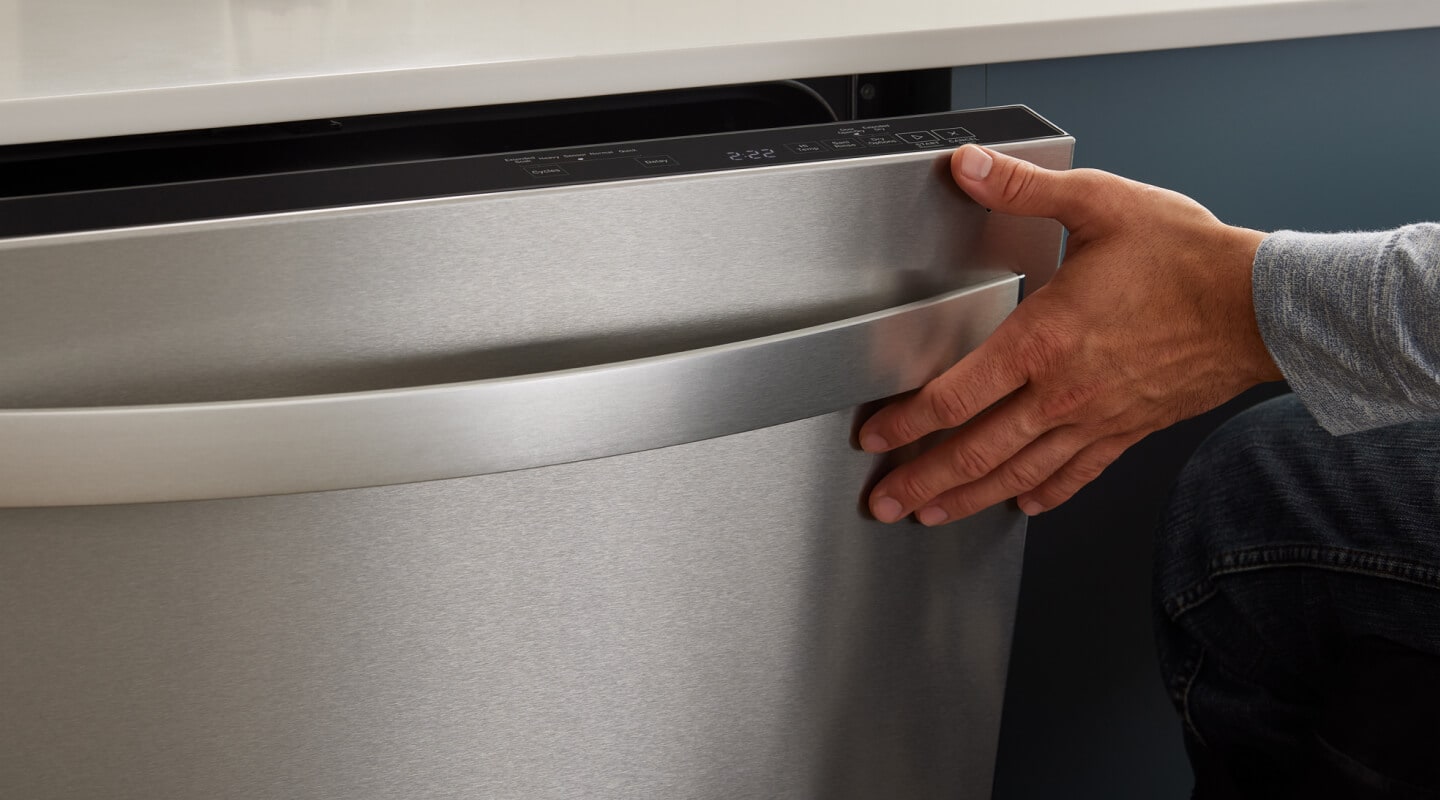
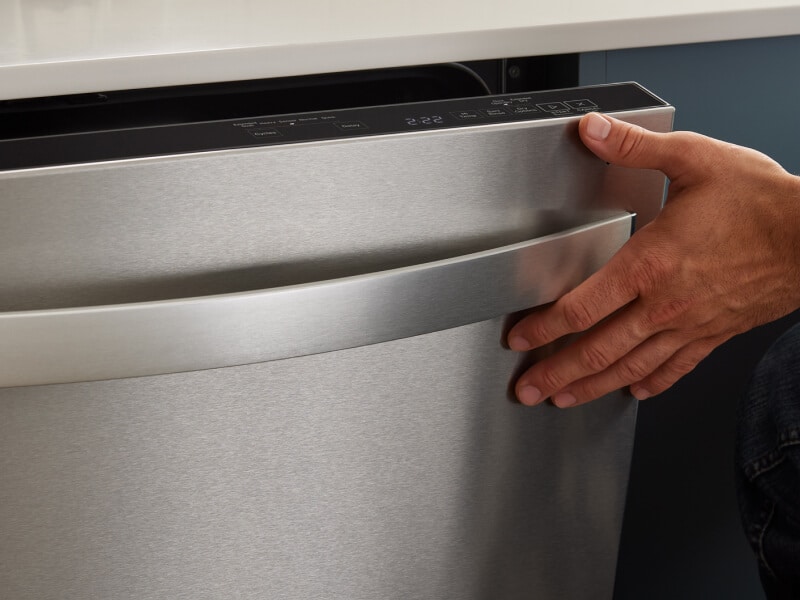
How long does it take to install a dishwasher?
Dishwasher installation time can vary depending on your level of experience, but generally speaking, the process can range from two to four hours. If you are installing a dishwasher for the first time, it is recommended to consult a professional for help with electrical and plumbing connections.
How much does it cost to install a dishwasher?
Depending on what needs to be done to install your dishwasher, installation can cost anywhere between $200-$500. Installation prices increase if you need to modify plumbing, wiring or countertops to successfully install the dishwasher, as these modifications often require professional assistance. Keep in mind that installation costs can also vary depending on your location.
Shop Whirlpool® Dishwashers
Whirlpool® Dishwashers help take care of dish duty for clean cookware, plates and utensils after mealtime. Convenient features on some models, such as a 3rd Rack or a 1-Hour Wash Cycle on this dishwasher from Whirlpool brand, help simplify cleanup so you can get back to what matters most.
Learn more about Whirlpool brand


home heartbeat
Ready for more tips, home hacks and appliance guides?



